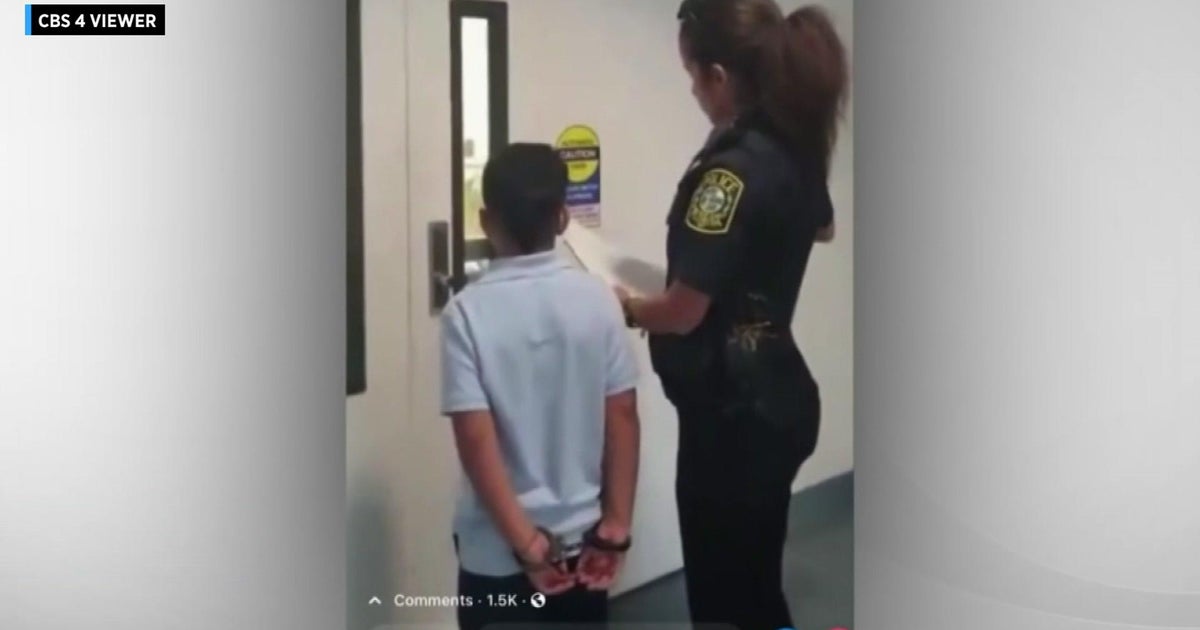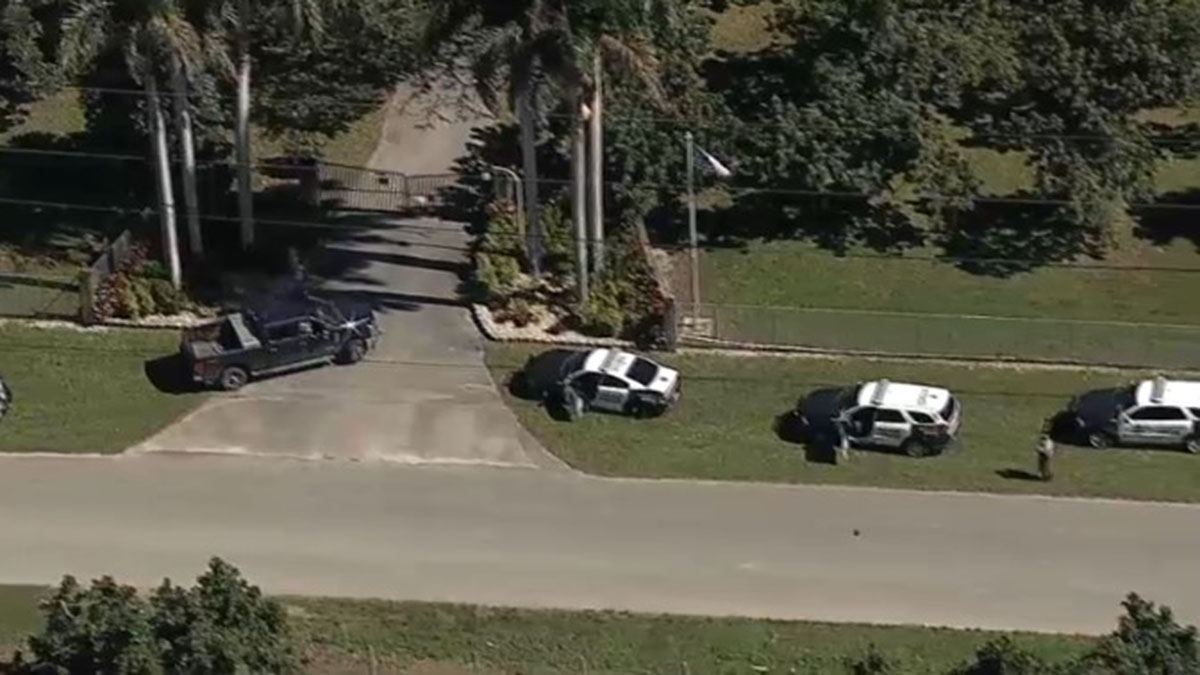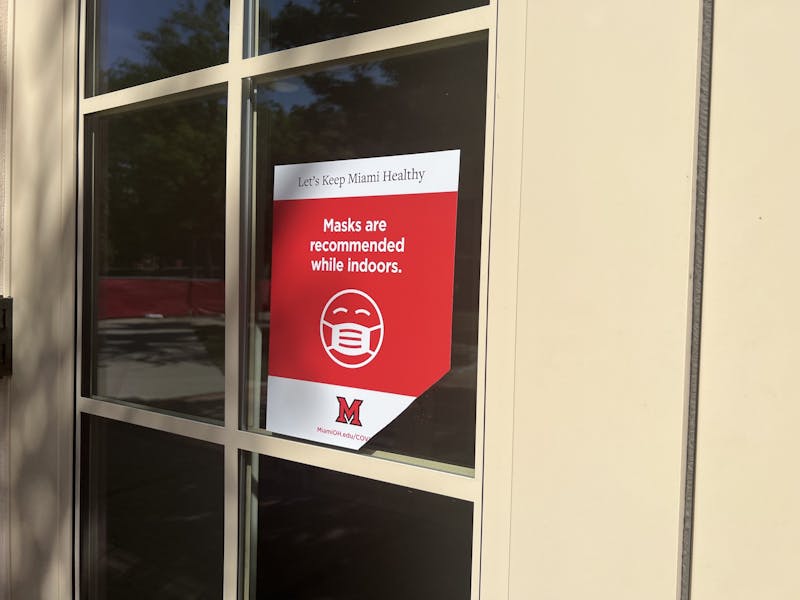Handcuffs in hallways: In-depth look at student arrests at Miami-Dade, Broward public schools

MIAMI – Alexander Fuentes can’t forget the day that changed his life forever.
January 25, 2018, the Miami child is seen being led in handcuffs from a Miami Dade school police car into Miami Children’s Hospital.
The video which was posted on social media caused a firestorm of controversy.
Fuentes was seven years old and a first grader at Coral Way K – 8 Center in Miami.
He spoke publicly for the first time about what happened to CBS Miami.
“Some bullies came up to me in the cafeteria and told me to mix rice with milk and the cafeteria lady said she would tell my teacher,” he said. According to the school district, the cafeteria worker told him to stop playing with his food and the situation escalated.
“She told my teacher, I got mad about it because I didn’t want to get in trouble and then I pulled her hair.”
The school district says it was more than pulling hair. They accused Fuentes of punching and kicking his teacher.
“They told me they were going to take me to the police cruiser and arrest me,” he says.
“It broke my heart. I said to the police and principal I said to everybody we don’t do that,” says Mercy Alvarez who is Alexander’s mother.
Alvarez and her husband, Rolando Fuentes say their son developed post-traumatic stress disorder afterward and he is still getting therapy. Rolando Fuentes says police gave him two choices, jail or a mental health evaluation.
“That officer said to me, we will either arrest or Baker act him and I said why? My kid has no problem. What’s the harm? They said we are gonna do it. You have no rights.”
Alexander Fuentes was taken to Children’s Hospital, where a discharge sheet shows that a doctor diagnosed him with “aggression” and told his parents to make an appointment with a psychiatrist.
“I didn’t understand what was happening,” he says
“When you have a minor under that stress you are expecting that person can grow normally. That will stay in their brain the rest of their life,” says Rolando Fuentes.
After the images of Alexander in handcuffs surfaced, Miami-Dade schools began grappling with modifying their school police procedures, but just 3 weeks after Alexander was cuffed.
The Parkland massacre happened and changes in the way young children at school are treated, accelerated.
“We’ve cut arrests down by half. Only one percent of incidents in schools lead to an arrest,” says Miami-Dade Schools police chief Edwin Lopez.
After the Parkland tragedy, police presence is required at all Florida schools. Miami-Dade schools added over 300 officers in the last four years and Lopez says that is what has made a huge difference in schools.
He attributes the decline in arrests to the civil citation program, officer discretion, and officer training. The civil citation program is an alternative to an arrest being made.
“When we talk about educating the whole child, cops play a vital role, mentoring and guiding. A lot of children are from single-parent households and our officers are guardians, encouraging them to make good choices benefitting them as an adult,” says Lopez.
The latest numbers reflect the changes. Last year, the Miami-Dade School District says out of a student population of 320,000, fewer than 200 children were arrested. That includes ‘no’ elementary school students, 57 children between the ages of 12 and 14, and 142 children between the ages of 15 and 18.
Compare that to pre-pandemic levels, when Miami-Dade Schools in 2018-2019 had 279 arrests.
“I was a big vexed relative to that data that came out at that particular time,” says Miami-Dade School Board member Dr. Steve Gallon. “That data was inconsistent with our student population. We have less than 25 percent African American students, but they represented over 50 percent of the arrests at the time,” said Gallon.
Based on Dr. Gallon’s work, Miami-Dade schools are now required to report the arrest numbers to the school board annually, but new data shows there’s still a racial disparity.
“Last year, 124 Black children were arrested. That’s still more than half the total.”
“So, when you look at a significantly higher number of African American males being arrested based on other groups, that tells us that we need to re-calibrate, refocus our efforts educationally, behaviorally, socially, and mentally on the needs of that particular student population,” says Gallon.
CBS 4 found that the number of student arrests is also going down in Broward County over the last three years.
Broward is the nation’s sixth-largest public school district with about 250,000 students.
In the 2018-19 school year, the district says 283 students were arrested. Compare that to the 2021-22 school year when 185 students were arrested, according to the district.
The breakdown of arrests in Broward: One elementary student, 59 middle school students, and 125 high school students, according to the demographics.
Black students represent 65 percent of the arrests. They make up 41 percent of the student population and Hispanic students were arrested 19 percent of the time. They are 37 percent of the student population.
One factor why fewer school children are being arrested points to police de-escalation.
You can see it at work in a Fort Lauderdale police body cam video from last fall. At the time, a ten-year-old student brought a handgun to Walker Elementary School.
The police officer is seen arriving at the school and going to the principal’s office where the child is sitting.
“Hey, buddy how are you, what is going on today?” the officer asks the child gently.
The officer is seen removing a 9-millimeter handgun from the child’s backpack. Then, the principal is heard addressing the child telling him in a calm voice, “Going back to class is not an option today. So, asking won’t change anything. Right now, we need to make sure that you are in a good state of mind and we can tell your mommy what’s happened.”
The child was not arrested or prosecuted.
Since being elected in 2020, Broward State Attorney Harold Pryor is changing the way children are treated, especially for minor offenses.
According to the Florida Department of Juvenile Justice, in the past year between 87 and 88 percent of eligible children in Broward who were considered first-time offenders were issued a ‘civil citation’ or other alternatives to arrest.
The state attorney credits a joint agreement between prosecutors, law enforcement and community partners with bringing down the arrest rate for children under 17, for misdemeanor offenses like disorderly conduct, vandalism and petty larceny.
And there are more changes ahead when it comes to arresting children.
At their November meeting in Sunrise, The Marjorie Stoneman Douglas Public Safety Commission revealed they are working on a standard to help schools effectively identify who is a real danger.
“Threat management is looking at behavior and determining, is this person on a pathway to violence and we need to off-ramp this before that person acts?” says Commission Chair Sheriff Bob Gualtieri of Pinellas County.
“There are a lot of counties in Florida who have no automated system. So, there’s room for opportunities in threat management which is the greatest opportunity to get to prevention,” says Sheriff Gualtieri.
Changes in attitude and treatment come too late for Alexander Fuentes. He is now in a private school and is an “A” student, according to his parents.
He says he learned a harsh lesson in first grade. “Putting a minor in jail is definitely wrong.”
While South Florida schools are reducing the number of children arrested, Alexander Fuentes’ parents say one child being arrested, is one too many.
“A lot of families have the same problem but they don’t talk about it,” says Mercy Alvarez. She hopes more parents will break the silence when their children are arrested and handcuffed at school.
“They should really put an effort into creating programs to help families in need,” agreed Rolando Fuentes.



